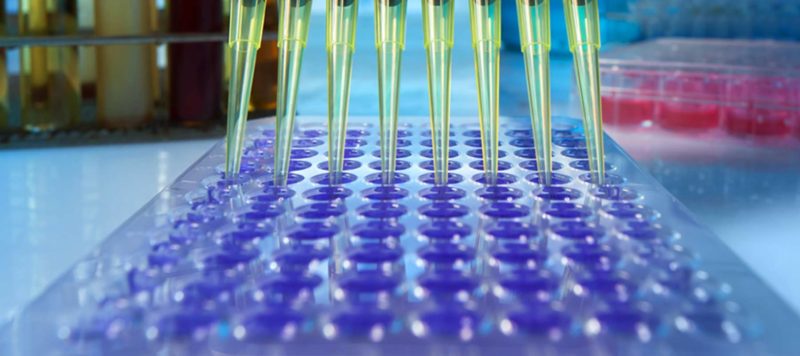PartnershipsProducts and SolutionsWhat Is an ELISA Sandwich Assay?

ELISA stands for Enzyme-Linked Immuno Sorbent Assay. There are several types of ELISAs, including the sandwich ELISA, indirect ELISA, direct ELISA, and automated ELISA, all of which are used to detect antibodies. So, why is an ELISA sandwich assay associated with a popular lunch menu item? It is called a sandwich because it uses two antibodies, with an antigen bound between them (somewhat like a sandwich). Read on to learn more about the ELISA sandwich assay, how it is different from other types, and what its process looks like.
What Is the Purpose of the ELISA Sandwich Assay?
Any ELISA is used to discover a target antigen in a blood sample. However, in a sandwich assay, the antigen is bound between detection and capture antibodies. In general terms, the capture antibody is immobilized on a microplate. In contrast, the detection antibody (conjugated to an enzyme or fluorophore label) is applied as the last step before detection. Compared to other ELISA types, the sandwich assay is more specific and sensitive and is better for more complex situations.
What Is the ELISA Sandwich Assay Process?
In most cases, the sandwich assay process is as follows:
- Coat with a capture antibody. The surface can be a magnetic bead or multi-well plate. After incubation, you should wash the unbound antibody to promote higher sensitivity.
- Block unbound protein binding sides on the surface. Using blocking buffers, such as bovine serum albumin (BSA), casein, or fetal bovine serum (FBS), can help reduce background and nonspecific binding.
- Add the target antigen (the sample). Incubate first so that the target antigens can bind with the capture antibodies. Then, wash to remove the unbound antigen.
- Add the detection antibody label conjugate. Then, incubate and wash.
- Detection. Measure absorbance, fluorescence, chromogenic, or chemiluminescent readout.
What Are the Pros and Cons of an ELISA Sandwich Assay?
The biggest advantage of a sandwich assay is its sensitivity (otherwise known as its detection limit). The sensitivity can increase dramatically if you have a high affinity and specificity of your primary and secondary antibody pair.
One drawback of the sandwich assay is that the second antibody can potentially produce an incorrect readout because the primary and secondary antibodies did not have high specificity and affinity. In this instance, it’s possible that the secondary antibody could bind to the capture antibody, thus giving a false readout.
What Are the Different Types of ELISA?
An ELISA sandwich assay uses a capture and detection antibody in its process. However, this sandwich method differs slightly from other ELISA types. Some other ELISA types include:
- Automated ELISA: An automated ELISA reader is part of a fully automated system that can perform all of the basic processes of ELISA, such as microplate washing, reagent dispensing, absorbance measurement, and incubation.
- Indirect ELISA: Indirect ELISA is a two-step process in which the primary antibody specific to the antigen binds to the target. A secondary antibody binds to the primary for detection.
- Direct ELISA: The antigen is immobilized to a multi-well plate in a direct ELISA, and detection occurs with an antibody specific to the antigen.
The ELISA sandwich assay is the most common of all the ELISA types.
Hudson Robotics has been the leading supplier of automated products for over 39 years. To learn more on how your lab can benefit from the ELISA sandwich assay, Covid testing, contact Verulam Scientific Ltd – The UK distributor and service provider for Hudson Robotics. Speak to a member of our technical team at [email protected] or call 01234 381000.




